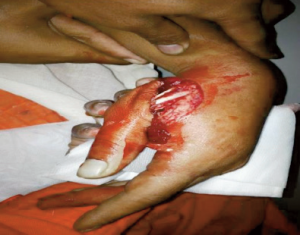The Charity
Aviation
Maritime
Mooring Line Hazards

Initial Report
 Report Text:
Report Text:
During mooring operations and whilst the aft tug boat was being cast off, an Able Seaman (AB) was holding the messenger attached to the tug line and did not let it go until it had almost reached the chock. There was potential risk of injury by the messenger, as caused by the AB’s inattention and improper assessment of risks.
Corrective action from lessons learned: Crew should always exercise due diligence during mooring/unmooring operations to ensure that the job is carried out safely following good seamanship practices. Proper supervision during mooring operations is an important safety issue. Amongst other responsibilities the supervisor has the duty:
a) To exercise full control of the working environment.
b) To ensure through a toolbox talk the work is under – taken with safety instructions and good seaman ship practices implemented at all times.
c) To prevent potential injury or damage through unsafe acts or omissions by the crew
d) To ensure crew members are always at a safe position as far as is reasonably practicable, outside the dangerous/snap-back zones of the mooring lines.
e) To maintain awareness, assess and react quickly and effectively to any new hazard that might occur.
Report Text:
A crewmember injured his hand during mooring operations. The incident occurred when a bunker barge was beginning an approach to the port side of a Platform Supply Vessel (PSV) at anchor, for bunkering operations. The crew of the bunker barge passed the “messenger line” to a crewman on the PSV, along with two mooring ropes. The crewman took the ropes and put the eyes of the two mooring ropes on each of the twin bollards aft and returned the messenger line to the bunker barge crew. The crewman on the PSV then considered that the mooring operation was over and started to walk away towards the accommodation. As he reached amidships the master of the bunker barge got his attention and indicated to him that he should go aft again and shift one of the mooring ropes to the other bollard. He returned to the aft bollard. The barge crew slackened the mooring rope a little and he tried to remove the rope. At that moment there was sudden tension on the rope, due to relative movement between the vessel and bunker barge.
The AB’s left palm got stuck between rope eye and bollard resulting in severe laceration to his left hand. First aid was given, before the AB was sent ashore to hospital for further treatment.
An investigation established the following: The incident occurred when the injured person agreed to shift the rope from one bollard to the other without insisting on the rope being sufficiently slackened. He failed to take into account the relative movement of the vessels, which led to his hand getting stuck between the eye of the rope and the bollard; VHF radio communication between the ship and barge was not established, there was no effective toolbox talk; the injured person was attending to the moorings alone, which was contrary to the job hazard analysis, which required attendance in pairs.
Lessons Learned:
a) Vessel’s bridge must establish VHF communication with another vessel before agreeing to start the mooring/unmooring operation;
b) Both forward and aft station deck crew to be in VHF communication with duty officer on the bridge;
c) Ship’s crew to take instructions from the duty officer and not from the barge crew directly;
d) Additional control measures during mooring and bunker ing operations should include the importance of risk assessment taking place before work starts;
e) Review the company Manual of Permitted Operations specifically with regard to weather conditions;
f) To ensure the Buddy System at workplace is in place, especially during night time operations, work as a team to spot dangers.
CHIRP Comment
The risks when handling mooring ropes of different types are well documented. The need for vigilance and diligent supervision at all times is essential. Appropriate Personal Protective Equipment (PPE) should be made available and worn.
See also The International Marine Contractors Association (IMCA) reports: SF 02/08 (Finger injury whilst casting off towing line) and IMCA SF 11/14 (LTI–Hand severed during mooring operations)







